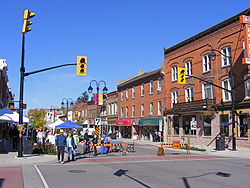Georgetown, ON
| Georgetown | |
|---|---|
| Unincorporated Community | |

Main Street
|
|
| Coordinates: 43°38′49″N 79°54′36″W / 43.64694°N 79.91000°WCoordinates: 43°38′49″N 79°54′36″W / 43.64694°N 79.91000°W | |
| Country | Canada |
| Province | Ontario |
| Regional municipality | Halton |
| Town | Halton Hills |
| Settled | 1837 |
| Dissolved | 1974 into Halton Hills |
| Government | |
| • Mayor (Halton Hills) | Rick Bonnette |
| Area | |
| • Total | 24.03 km2 (9.28 sq mi) |
| Elevation | 258 m (846 ft) |
| Population (2016) | |
| • Total | 42,123 |
| • Density | 1,753.1/km2 (4,541/sq mi) |
| Time zone | EST (UTC−5) |
| • Summer (DST) | EDT (UTC−4) |
| Forward sortation area | L7G |
| Area code(s) | 905 / 289 / 365 |
| Highways |
|
| NTS Map | 030M12 |
| GNBC Code | FBHBE |
| Website | http://www.haltonhills.ca/ |
Georgetown is a community in the town of Halton Hills, Ontario, Canada and is part of the Regional Municipality of Halton. The town includes several small villages or settlements such as Norval, Limehouse, Stewartown and Glen Williams near Georgetown as well as another large population centre, Acton, Ontario. In 2016, the population of Georgetown was 42,123. It is situated on the Credit River, located approximately 60 km west of Toronto, making it part of the Greater Toronto Area. Georgetown was named after entrepreneur George Kennedy who settled in the area in 1821 and built several mills and other businesses.
By 1650, the once plentiful Hurons had been wiped out by European diseases, and the Iroquois. The region was now open to the Algonquian Ojibwa (also known as Mississauga), who moved in. By 1850 the remaining Mississauga natives were removed to the Six Nations reserve, where the New Credit Reserve was established.
Commencing in 1781, the British government purchased blocks of land from the Mississauga Nation. In 1818, they purchased land that later became the townships of Esquesing and Nassagaweya. The task of laying out the townships fell to Timothy Street and Abraham Nelles. Charles Kennedy was hired by Nelles to survey the northern part of Esquesing Township in 1819, and Charles Kennedy received a significant parcel of land as payment for his work. The brothers of Charles Kennedy, John, Morris, Samuel and George, all acquired land close to each another in the Silver Creek Valley. Charles Kennedy built a sawmill in a location where Main Street meets Wildwood Road today.
George Kennedy (businessman) took advantage of the Silver Creek in the early 1820s to power a sawmill, and later a gristmill and foundry and then a woolen mill; a small settlement formed around the mills, often called "Hungry Hollow". In 1828, John Galt of the Canada Company opened the York to Guelph Road (now Highway 7) which connected the settlement around George Kennedy's Mill with other settlements in the area. The road alo extended to Galt, Ontario, to Guelph, Ontario and to Goderich, Ontario.
...
Wikipedia
